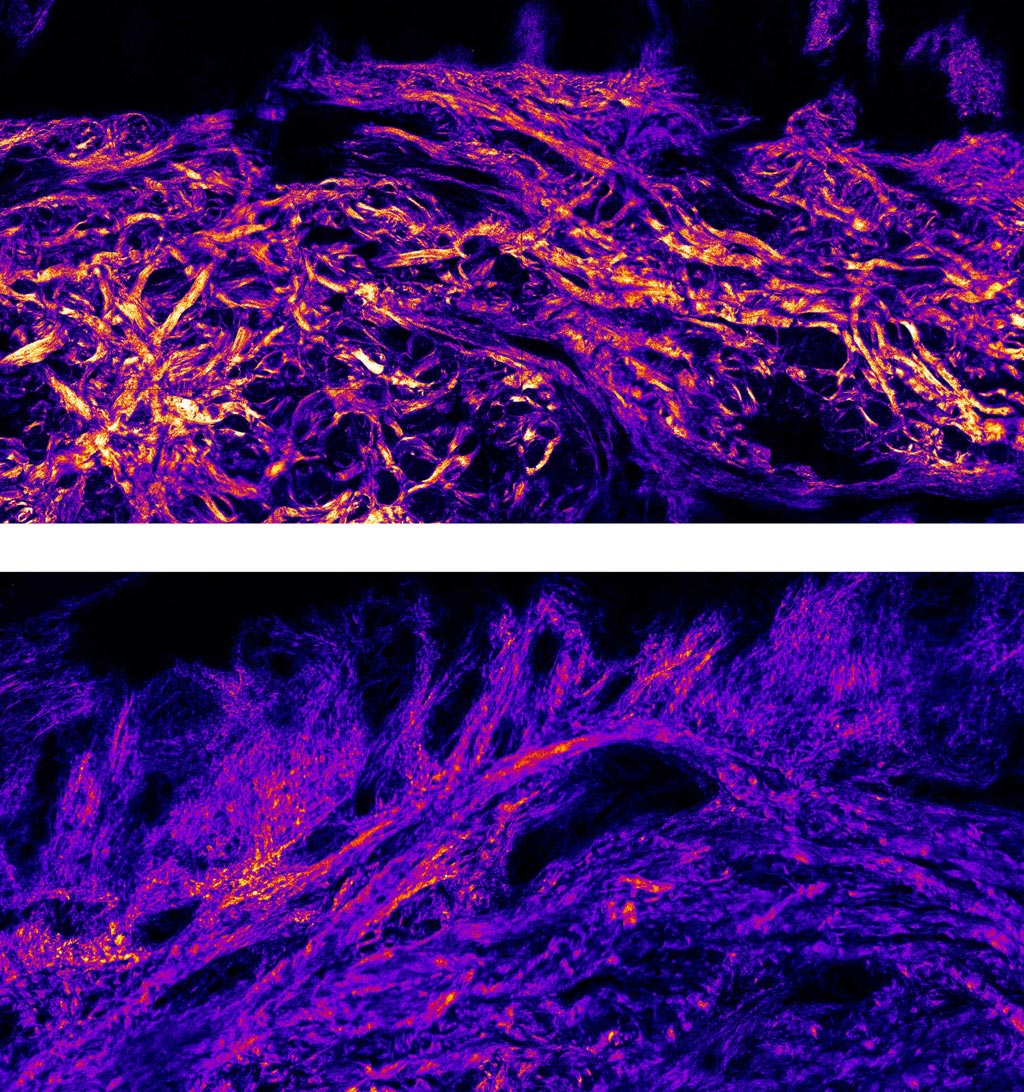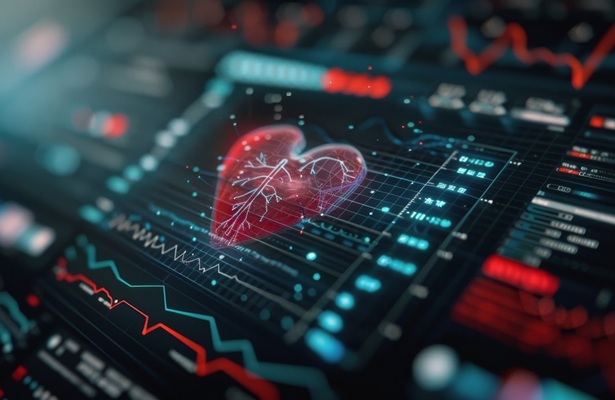Transplanted Plantar Skin Cells Could Reduce Stump Injury
|
By HospiMedica International staff writers Posted on 30 Oct 2019 |

Image: Collagen bundles fibers are much thicker in plantar skin (T) than body skin (B) (Photo courtesy of Imperial).
Re-engineering stump skin using skin cells from the sole of the feet could help amputees tolerate prosthetics more comfortably, according to a new study.
Researchers at Imperial College London (Imperial; United Kingdom) developed computational models to analyze the make-up of the skin on the soles of the feet, and how it behaves differently to regular skin under pressure. They found that the outermost layer of sole skin, the stratum corneum, plays the biggest role in protecting skin from tears and blisters, as it is much thicker in sole skin than other skin types. They also found that the thickness of the skin was not the key factor, but rather how the structural proteins, keratin and collagen, were arranged.
Plantar epidermis, which lies below the stratum corneum, contains far more total keratin, as well as different types of keratin, than in other skin, helping sole skin to resist breakages. Similarly, collagen is arranged in much thicker bundles, and the collagen fibers themselves are thicker. The combination of all these factors result in plantar skin that is tougher and more resistant to injury than body skin, which could be useful characteristics for amputees, if they could be incorporated in stumps. The researchers have already defined several potential avenues to do so.
These include incorporating genetic material into stump skin to help it grow thicker, and using sole skin-inspired skin grafts. The researchers also suggest manipulation of the genetic material that’s already in stump skin to change its make-up. For example, fibroblasts could be transplanted, which could trigger the production of collagen and alter the type of keratin produced, making skin layers thicker over time.
Alternatively, plantar skin cells could be grown in-vitro, which could then be grafted onto stumps. The study was published on October 9, 2019, in Science Advances.
“A thick stratum corneum is most important to protect skin from stress-induced injuries such as skin tears and blisters, while the composition of each skin layer is most important for protection against deformation-induced injuries such as pressure ulcers,” said senior author Claire Higgins, PhD, of the department of mechanical engineering. “The combined approach of multiscale mechanical testing and computational modeling can now be extended to investigate age-related skin changes and to enhance the load tolerance of engineered skin substitutes.”
Related Links:
Imperial College London
Researchers at Imperial College London (Imperial; United Kingdom) developed computational models to analyze the make-up of the skin on the soles of the feet, and how it behaves differently to regular skin under pressure. They found that the outermost layer of sole skin, the stratum corneum, plays the biggest role in protecting skin from tears and blisters, as it is much thicker in sole skin than other skin types. They also found that the thickness of the skin was not the key factor, but rather how the structural proteins, keratin and collagen, were arranged.
Plantar epidermis, which lies below the stratum corneum, contains far more total keratin, as well as different types of keratin, than in other skin, helping sole skin to resist breakages. Similarly, collagen is arranged in much thicker bundles, and the collagen fibers themselves are thicker. The combination of all these factors result in plantar skin that is tougher and more resistant to injury than body skin, which could be useful characteristics for amputees, if they could be incorporated in stumps. The researchers have already defined several potential avenues to do so.
These include incorporating genetic material into stump skin to help it grow thicker, and using sole skin-inspired skin grafts. The researchers also suggest manipulation of the genetic material that’s already in stump skin to change its make-up. For example, fibroblasts could be transplanted, which could trigger the production of collagen and alter the type of keratin produced, making skin layers thicker over time.
Alternatively, plantar skin cells could be grown in-vitro, which could then be grafted onto stumps. The study was published on October 9, 2019, in Science Advances.
“A thick stratum corneum is most important to protect skin from stress-induced injuries such as skin tears and blisters, while the composition of each skin layer is most important for protection against deformation-induced injuries such as pressure ulcers,” said senior author Claire Higgins, PhD, of the department of mechanical engineering. “The combined approach of multiscale mechanical testing and computational modeling can now be extended to investigate age-related skin changes and to enhance the load tolerance of engineered skin substitutes.”
Related Links:
Imperial College London
Latest Surgical Techniques News
- Minimally Invasive Endoscopic Surgery Improves Severe Stroke Outcomes
- Novel Glue Prevents Complications After Breast Cancer Surgery
- Breakthrough Brain Implant Enables Safer and More Precise Drug Delivery
- Bioadhesive Sponge Stops Uncontrolled Internal Bleeding During Surgery
- Revolutionary Nano Bone Material to Accelerate Surgery and Healing
- Superior Orthopedic Implants Combat Infections and Quicken Healing After Surgery
- Laser-Based Technique Eliminates Pancreatic Tumors While Protecting Healthy Tissue
- Surgical Treatment of Severe Carotid Artery Stenosis Benefits Blood-Brain Barrier
- Revolutionary Reusable Duodenoscope Introduces 68-Minute Sterilization
- World's First Transcatheter Smart Implant Monitors and Treats Congestion in Heart Failure
- Hybrid Endoscope Marks Breakthrough in Surgical Visualization
- Robot-Assisted Bronchoscope Diagnoses Tiniest and Hardest to Reach Lung Tumors
- Diamond-Titanium Device Paves Way for Smart Implants that Warn of Disease Progression
- 3D Printable Bio-Active Glass Could Serve as Bone Replacement Material
- Spider-Inspired Magnetic Soft Robots to Perform Minimally Invasive GI Tract Procedures
- Micro Imaging Device Paired with Endoscope Spots Cancers at Earlier Stage
Channels
Critical Care
view channel
AI Heart Attack Risk Assessment Tool Outperforms Existing Methods
For decades, doctors have relied on standardized scoring systems to assess patients with the most common type of heart attack—non-ST-elevation acute coronary syndrome (NSTE-ACS). The GRACE score, used... Read more
'Universal' Kidney to Match Any Blood Type
Blood-type incompatibility has long been one of the greatest obstacles in organ transplantation, forcing thousands of patients—particularly those with type O blood—to wait years longer for compatible donors.... Read morePatient Care
view channel
Revolutionary Automatic IV-Line Flushing Device to Enhance Infusion Care
More than 80% of in-hospital patients receive intravenous (IV) therapy. Every dose of IV medicine delivered in a small volume (<250 mL) infusion bag should be followed by subsequent flushing to ensure... Read more
VR Training Tool Combats Contamination of Portable Medical Equipment
Healthcare-associated infections (HAIs) impact one in every 31 patients, cause nearly 100,000 deaths each year, and cost USD 28.4 billion in direct medical expenses. Notably, up to 75% of these infections... Read more
Portable Biosensor Platform to Reduce Hospital-Acquired Infections
Approximately 4 million patients in the European Union acquire healthcare-associated infections (HAIs) or nosocomial infections each year, with around 37,000 deaths directly resulting from these infections,... Read moreFirst-Of-Its-Kind Portable Germicidal Light Technology Disinfects High-Touch Clinical Surfaces in Seconds
Reducing healthcare-acquired infections (HAIs) remains a pressing issue within global healthcare systems. In the United States alone, 1.7 million patients contract HAIs annually, leading to approximately... Read moreHealth IT
view channel
Printable Molecule-Selective Nanoparticles Enable Mass Production of Wearable Biosensors
The future of medicine is likely to focus on the personalization of healthcare—understanding exactly what an individual requires and delivering the appropriate combination of nutrients, metabolites, and... Read moreBusiness
view channel
Philips and Masimo Partner to Advance Patient Monitoring Measurement Technologies
Royal Philips (Amsterdam, Netherlands) and Masimo (Irvine, California, USA) have renewed their multi-year strategic collaboration, combining Philips’ expertise in patient monitoring with Masimo’s noninvasive... Read more
B. Braun Acquires Digital Microsurgery Company True Digital Surgery
The high-end microsurgery market in neurosurgery, spine, and ENT is undergoing a significant transformation. Traditional analog microscopes are giving way to digital exoscopes, which provide improved visualization,... Read more
CMEF 2025 to Promote Holistic and High-Quality Development of Medical and Health Industry
The 92nd China International Medical Equipment Fair (CMEF 2025) Autumn Exhibition is scheduled to be held from September 26 to 29 at the China Import and Export Fair Complex (Canton Fair Complex) in Guangzhou.... Read more














